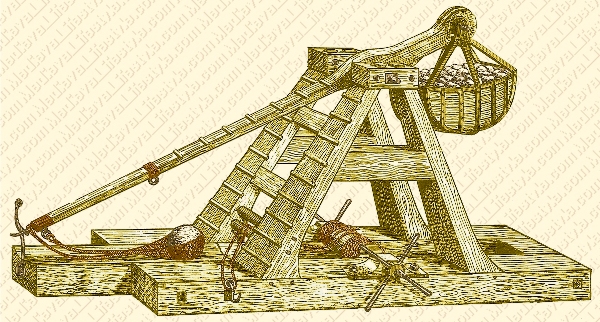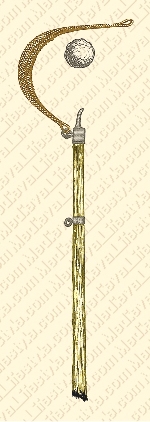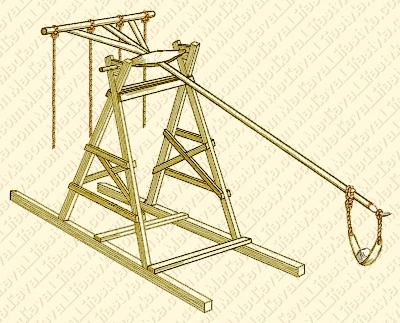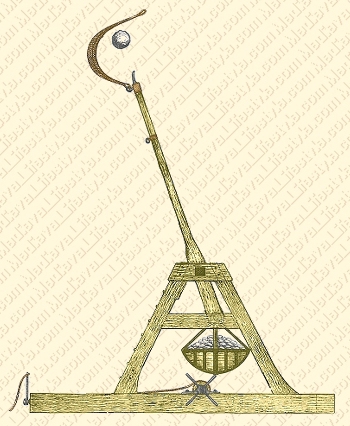The Trebuchet

The mightiest of the mechanical siege weapons and the latest to emerge during the Middle Ages, the Trebuchet used the physical principles of leverage and centripetal force to hurl the largest, most deadly payloads toward their targets. Simple in principle, the trebuchet employed a sling arm powered by a falling load.
Ancient fortifications eventually gravitated toward thick stone construction because of the immense damage possible from bombardment with stone-throwing weapons and other operations (see Medieval Castles for more information on castle sieges), but even the thickest castle walls could not withstand repeated assault from a large trebuchet.
This engine, the largest of the siege artillery of the Middle Ages, was not drawn from the legacy of Greece and Rome as were the ballista and catapult. The Trebuchet's humble ancestry begins with the ancient Staff Sling.

The Staff Sling
The staff sling had been utlized from the Far East to Eastern Europe for many centuries prior to the appearance of the Trebuchet. This one-person weapon was simply a pole to which a sling was attached. One end of the sling was firmly attached near the end of the pole, the other sling end was looped loosely over a notch or hook, and the sling was loaded with a stone or other ammo of manageable size.
A soldier would swing the staff in a 180-degree arc from behind him forward. The loose end of the sling would slip off the pole, and therefore the centripetal force (center-seeking) could no longer hold the stone, thereby launching it forward. In order to flatten the trajectory of the shot, a hook with a slight forward curve was attached to or carved into the end of the pole.
The Perrier
Although the staff sling continued to be used because it was light-weight and convenient to carry, it was natural to try to improve on the beam-sling machine. The Perrier (or as it was called in the Near East, the Manjaniq) was basically the staff-sling arm mounted on a frame.

These precursors of the trebuchet were traction powered (see Siege Engine Mechanics) and therefore are often referred to as traction catapults or traction trebuchets. The beam was mounted on a frame and pivoted on a fulcrum, and a rope or ropes were attached to the shorter end. Upon command of a shooter, troops would forcefully pull the ropes down, and the long end of the beam would fling the loaded sling.
Perriers varied from a small, one-person weapon to a larger beam pulled by many soldiers or even a team of horses. At any size the traction-powered perrier was a very effective weapon because it could be quickly reloaded and fired.

The Bigger the Better
Perrier-type weapons can be traced back in China to the pre-Christian era, and these machines were used extensively in the Near East during the Middle Ages.
There is a logical evolution from the perrier to the trebuchet resulting from two factors: First, the desire to increase the size and weight of the missile meant that more pulling power was needed. Very large machines could hurl huge boulders when powered by falling loads of stone or metal, and fewer artillery personnel were needed to man the weapon.
Secondly, a group of troops pulling a sling arm simultaneously will never reproduce the exact force from shot to shot. In order to consistently control the distance a missile will travel, the pulling force must not vary.
The technique of dropping a counterpoise (counterweight) of heavy materials solved both problems. The form of the counterweight also evolved into a hinged basket design which allowed the load to fall in a more straight path, increasing efficiency.
Large trebuchets of the late Middle Ages would probably be constructed on site from local timber. (Some sieges took many months, even years. For more info on sieges, see Medieval Castles.) Besieging armies would therefore only need to transport the hardware for the machine. Even so, the hardware for one large trebuchet could load up to 30 wagons.
The Medieval Trebuchet is an engineering marvel and a testament to what can be accomplished with simple mechanics.
See Medieval Castles for more information on castle sieges.
For information on other siege engines see our main Siege Engines page.